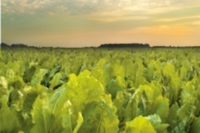
When Stéphane Glacier visited The French Pastry School in Chicago this past June to conduct a course on sugar showpieces, one of the first things he told the students gathered was how lucky they were.
“They were going to learn in three days what it took me 15 years to discover,” he explained. Having captured the prestigious Meilleurs Ouvriers de France (M.O.F.) when he was 30, as well as having coached the French team to a World Pastry Championship in 2006, Glacier is recognized as one of the world’s leading sugar confectionery artists.
Glacier’s passion for working with sugar, however, dovetails with his intensity to share that knowledge with professionals and amateurs alike.
Having already published 15 books since embracing the profession of confectioner as an apprentice at the age of 16, the 38-year-old Glacier laments the fact that many candymakers aren’t attuned to the ingredient technology critical to their craft.
“They must learn the composition of ingredients,” he asserts. “As a candy maker, you need to know what’s the composition of sugar, how to cook it, what happens when you cook it long or short, and why it turns to yellow when you do.
“You don’t have to be a chemist, but you need to know what’s going on to be a good candy maker,” he asserts.
Glacier goes on to explain how slight adjustments based on this knowledge can help improve one’s craft.
“Let’s say you’re making a ribbon of sugar,” he says. “When you cook a kilo of sugar, you’ll find that there will always be crystals in the ribbon. However, if you use 1.5 kilos of sugar and cook it longer, you don’t have any crystals.
“Everyone talks about cooking sugar to a certain temperature, say 165 or 170 degrees,” Glacier continues. “But if you bring the sugar to this temperature in 20 minutes as opposed to 40 minutes, you have two completely different recipes. First, the effects of temperature and humidity are different. Then there’s sugar induction and the advent of color. Finally, the crystallization is different.”
To Glacier, knowing sugar is a prerequisite to working with it. After-wards, it’s a matter of practice, practice, and more practice. Add a good dose of passion to the formula and one begins to master the art.
In Glacier’s case, the call came when he was 12. That’s when Glacier’s uncle took him to Paris for the Europain show. This biennial bakery, pastry and confectionery show draws a multitude of exhibitors as well as professionals from not only France, but the entire world.
It was at Europain that Glacier saw chefs pulling sugar. In fact, one of the those chefs, Joel Bellouet, a renowned pastry chef and a sugar confectionery artist, was the man who enthralled the impressionable young lad. He would eventually become Glacier’s mentor.
At 16, Glacier began his formal apprenticeship in Normandy at a pastry shop, subsequently moving onto Paris where he had the opportunity to work in several large pastry shops.
“I always picked a pastry shop where I could work on everything, as opposed to a place where I would be just a specialist,” he explains.
It was in Paris that Glacier came in contact with fellow countryman and pastry chef, Jacque Torres. Torres eventually convinced him to come to New York City, where he joined Torres at the famed Le Cirque restaurant.
Six months later, Torres helped Glacier land a pastry chef position at Tropical restaurant where he worked for two and a half years. While refining his skills in the pressure-cooker world of New York restaurants, Glacier realized that future personal and career growth lay in attaining the M.O.F.’s famed bleu-blanc-rouge (blue-white-red) collar. As a result, Glacier decided to return to France.
In an irony that only fate could conjure up, the still young pastry chef found himself teaching at Bellouet’s school in Paris. It was his five-year stint here that enabled him to take his mastery of sugar to a higher level.
“When I was teaching at school, I was working with sugar all the time,” he explains. “Unlike a pastry shop, where you put in eight, 10 or more hours working on what’s required, and then later try to find some time to practice with sugar, I was teaching and training with it simultaneously. At school I would often use up 100 kilos of sugar weekly.”
In preparing himself for the M.O.F. competition, Glacier knew he needed to spend some time with other confectionery skills, such as chocolate. Unlike sugar, Glacier feels less comfortable working the Mayans’ famed ingredient.
“Maybe because I’m always rushing,” he says. “If you give me sugar, in two hours you can have a sculpture ready. With chocolate, you need to crystallize, let it cool down. It just takes more time. Sugar is more instinctive for me. It’s quick for me to make the sugar, create two flowers, and then pull something else together.”
During the M.O.F. competition, Glacier, indeed, pulled everything together, earning his colors at the young age of 30. That’s when his life changed.
The famed blue-white-and-red collar enabled him to expand his career path and go into consulting. As he explains, “When you have the M.O.F. title, the collar, no one asks for credentials.”
Since 2001, Glacier has been traveling extensively, mostly in the United States and Asia. He’s called to create showpieces for new hotels as well as sculptures for product demonstrations. In between traveling, he spends most of the time teaching, not only at places such as The French Pastry School in Chicago, but at his own schools.
“I have a school just south of Paris, which is open to both amateurs and professionals as well as one in the south of France, which is only open to professionals,” he says. Next to the school in Paris, there’s also a retail shop, where consumers can order the most exquisite of pastries, chocolates and sugar items.
Recognizing that chocolate continues to attract both media and consumer attention, Glacier remains one of the few spokesmen for fine sugar confections.
“In confectionery, there’s a place for everything, for all kinds of sweets,” he says. “Everything can be sold, you have to believe in what you do.”
He cites France as a classic example of what creativity can do to a segment or product line deemed out of touch.
“In France, you can’t sell lollipops,” Glacier explains. “But in my shop, we sell 100 lollipops a week. We have special moulds. You have to show the customer what you can do. Everything has to be transparent. We use a basic recipe but all the ingredients are natural, all the flavors and colors as well. When customers walk into our shop, they see them being made. And they buy them while they’re still warm.”
In addition, Glacier has plans to open up another retail outlet, one that’s more of a showroom than a traditional pastry shop.
“It’s located 15 kilometers from Paris and will feature only photographs and showpieces on display,” he says. “Customers will only be able to buy items based on orders. It’s a brand new concept and we’ll see how successful it is before developing more of them throughout France.”
The opening of his new concept shop, coupled with his commitments to the two schools and publishing – he has three new books in the works – means Glacier will seriously curtain his traveling.
“It’s difficult running a business while evolving one’s art,” he admits. At the same time, there’s Glacier’s strong desire to share his knowledge with budding as well as experienced confectioners.
In that vein, the sugar master points out that competing has proven tremendously valuable for him in honing his craft.
“When you’re competing, you share knowledge, you learn from the competitors,” Glacier explains. “Moreover, you learn respect. Just because you’re from France, doesn’t mean you’re the only one that can make candy. Someone can be from an obscure place and still be an excellent candymaker. So you learn humility.”
The great ones always do.
For additional information about Stéphane Glacier or The French Pastry School, visit www.stephaneglacier.com or www.frenchpastryschool.com.
Stephane Glacier Recipe
Orange or mint twistsIngredients:
2kgs white cane sugar
800g water
700g glucose
30 drops tartaric acid
Desired quantity of essential oil
Desired quantity of colouring
Method:
Melt the sugar in the water and bring to the boil in a copper pan. Add the glucose and cook at 162°c. At 140 ° c add the tartaric acid. Add the flavouring to the sugar mass (orange or mint). Pour 2/3 of the mixture onto a silpat mat. Color the remaining mixture yellow or orange. Pour half of the remaining mixture onto a silpat mat. Color the rest green or red. Pour out the rest of the sugar mixture. Cool the white sugar mass. Take ¾ and work it so that it becomes very white and opaque. Take the remaining white mass, the yellow or orange and the green or red and work until they become very shiny.
Assembly:
Take the white opaque mass and make a large roll keeping it warm with the lamp. With the other sugar masses (white, orange and red) or (white, yellow and green) make a large “ribbon” wide enough to completely cover the roll of white sugar. Pull and twist to obtain a round band 1 cm in diameter. Cut into twists. Store in a airtight container.
Coffee caramel
Ingredients:
380g sugar
300g glucose
80g water
30g coffee beans
500g liquid cream 35% fat content
50g inverted sugar
20 g crystallised sorbitol
1g bicarbonate
50g butter
Total weight before cooking: 1471g
Method:
In a copper pan cook the sugar, the water and the glucose at 145°C. Bring the cream to the boil in a saucepan with the coffee beans, the inverted sugar, the sorbitol then the bicarbonate. Deglaze the sugar. Sieve. Re-cook together to 117/118°.“Cuire au doigt”. Add the butter. Mix then pour between two guides 8 mm-1 cm in thickness. Leave to cool then cut with a knife to the size required. Store in an airtight container.
Passion fruit and apricot jellies
Ingredients:
800g pear pulp
400g passion fruit pulp
400g apricot pulp
150g caster sugar
42g yellow pectin
1500g caster sugar
150g glucose
11g tartaric acid
11g water
Weight total mass: 3464g
Cut out size: 22.5 X 22.5
Cooking with refract meter: 76°brix
Method:
Boil the pulp together. Mix the dry sugar and the pectin, then, when boiling add to the pulp. Mix. Bring to the boil again then add the sugar and the glucose. Cook to a heat of 76° on the refract meter. Add the acid then pour into a tin or between two guides to a thickness of 1 cm. Cut with a guitar cutter.Roll in granulated sugar.
Raspberry and vanilla liquor
Ingredients:
500g caster sugar
200g water
100g raspberry alcohol at 60° or 150g raspberry alcohol at 40°
1 vanilla bean
Method:
Cook the sugar, water and vanilla bean in a copper pan. Cook at 116°C /117°C. Deglaze the sugar with the raspberry alcohol and mix by pouring back and forth three times between the pan and the round bottomed bowl. Never use a whisk or a spatula to mix. Indent a hot and dry starch frame with a leaf motif. Pour the liquor with the help of a funnel into the indentations and dust with hot starch to cover the liquors and to seal the starch frame.Leave to crystallize for 4 hours. Turn the frame over between two trays and leave to crystallize again for 8 hours. Remove the liquors from the starch and brush. To finish, coat the liquors in dark coating chocolate (ultimate) 70 % or spray well with a coating mixture 50% cocoa butter and 50% dark coating chocolate




